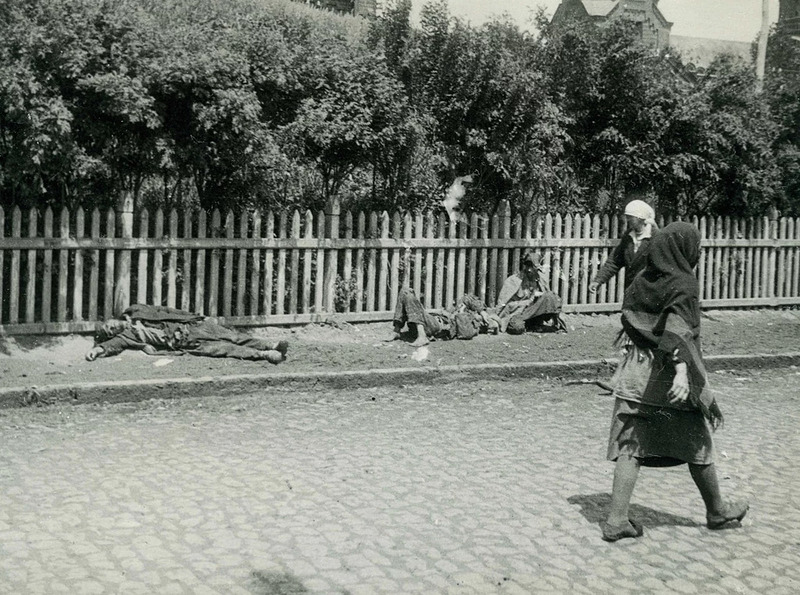Soviet Ukraine was born in late 1917, existed briefly in 1918, and re-emerged in 1919. By 30 December 1922, when it joined the USSR as the Ukrainian Socialist Soviet Republic, the communists had clashed for power and territory with, among others, Ukrainian People’s Republic, General Denikin, German-sponsored Second Hetmanate, and again UPR, allied with Poland. Only after the 1921 Treaty of Riga did they consolidate their rule over the bulk of Ukraine – and this part, compared to the regions that ended up within Polish, Czech or Romanian borders, drew the shorter straw.
Ukraine joined the Soviet Union just as its war communism – extreme centralization of power and total control of production by the state – was making way for Lenin’s New Economic Policy. Seeing how the previous doctrine had ruined the state and, combined with drought, brought about the 1921-1922 famine that killed milions (including hundreds of thousands Ukrainians), the Bolsheviks decided to introduce a temporary measure of free market, at least in agriculture. From 1922, the Soviet republics, Ukraine included, began slow recovery.
In early and mid-1920s, the communists, trying to strengthen their power, also allowed national aspirations of the Union’s peoples to surface, and even fostered local cultures. At the same time, they were preparing to transform the agricultural economy into an industrialized one. In 1928, Stalin ended NEP with his first five-year plan and speeded up industrialization. Shortly thereafter, in 1929, the countryside was hit with collectivization, aimed at turning peasants, land owners, into forced laborers of the state, slaving away on the nationalized land that used to be theirs.
The whole of USSR saw revolts against the new policy, slaughtering of farm animals and destruction of machines, but the Ukrainian dissent was the most pronounced. Stalin, who remembered the UPR, decided to break this "Ukrainian nationalism" with dekulakization – mass murder and deportation campaign – plus the increase in food quotas to be delivered and confiscation of any surplus. The result was one of the worst famines in the history of mankind, engineered starvation of four to seven milion people on fertile Ukrainian soil, a Soviet plan that crippled Ukrainian peasantry.
The peasantry were historically the base of culture and traditions, both closely linked to religion and the local Orthodox Church – which from early 1930s was hit by severe repressions as well. There was more: parallel to the famine, Ukrainian party leaders, ten years before encouraged by Lenin to promote Ukrainization, were purged, and the survivors sidelined when the capital was moved from Kharkiv to Kyiv in 1934. Sovietization replaced Ukrainization: Ukrainian cultural institutions and newspapers were shut down, the language marginalized, the people harassed.
The famine was a major blow aimed at cutting Ukrainian national identity at the knees through the decimation of the peasant class. Another one was a direct attack on intelligentsia, which, in Stalin’s opinion, was leaning too much toward the West: in late 1920s, only 20% of books in Ukraine were translations of Russian writers, while the rest were penned by local authors or translated from western languages. From 1933, places like the Slovo Building in Kharkiv, a haven of Ukrainian intellectual activity, would not be permitted to last and its members to live.
And in this organized assault on the very idea of Ukraine, thousands of leading Ukrainian authors, journalists, artists and educators found themselves persecuted, imprisoned and usually executed. A great number ended up in the Solovki special camp, but not for long: on 3 November 1937 in Sandarmokh, NKVD officer Matveyev, his only education being two years of elementary school, made poet and translator of Horace Mykola Zerov lie facedown in a shallow grave and shot him in the back of the head - and with him, hundreds of other members of the "Executed Renaissance."
Then, the 1937-1938 Great Terror purged the CP(B)U, the communist party, and NKVD members in Ukraine, while famous Order no. 00447 ("Concerning the Punishment of Former Kulaks, Criminals and Other Anti-Soviet Elements") gave the security services quotas of people to persecute and execute, and the NKVD troikas a carte blanche to persecute and execute anyone they wanted. Such policy removed yet more thousands of Ukrainians – either from the face of the earth or into Siberian labor camps, and the vast majority were victims of blanket terror, not purges.
After WWII, the reign of Soviet terror returned, first under Khruschev, since 1938 the First Secretary of the CP(B)U, then under Melnikov. Post-war repression campaign was mostly of "anticosmopolitan" nature because it targeted people suspected of disloyalty or infecting the Soviet society with western influences: real or alleged Nazi collaborators, as well as former POWs and forced laborers returning home. This period also saw a renewed attack on intelligentsia; survivors of the 1930s slaughter, allowed to foster patriotic sentiments in WWII, were in late 1940s accused of "Ukrainian nationalism" and persecuted.
By the time Stalin died in 1953 and Khruschev delivered his "On the Cult of Personality and Its Consequences" speech in 1956, Ukraine lost yet more hundreds of thousands people – deported, imprisoned and executed. The Khruschev thaw began the last three and a half decades of Ukraine in the Soviet Union – slow revival of culture and returning Russification, as well as the birth of dissident movements and resulting repressions from Moscow-controlled security apparatus, all this against the background of gradually deteriorating economy.
After the first three and a half decades, which cut the population of Ukraine by almost a third and its elites by four-fifths – the other three and a half were, at best, only lesser evil. The history of Soviet Ukraine is seven decades or repressions, planned genocide and countless human tragedies.
